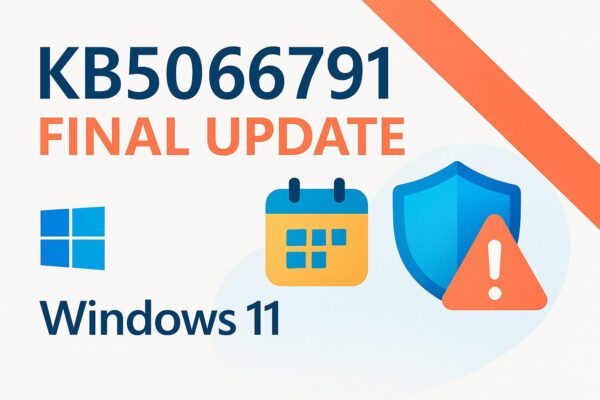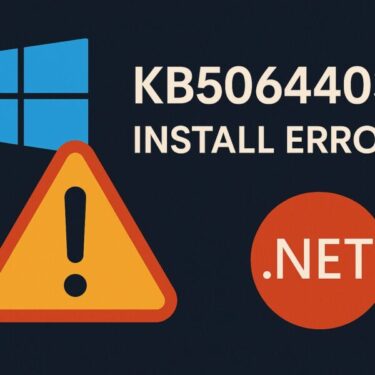
Introduction — Why this matters
KB5066791 is the final monthly Patch Tuesday security update for Windows 10. After installing it, version 22H2 becomes build 19045.6456 and version 21H2 becomes build 19044.6456. From this point forward, free monthly security updates end for Windows 10. To keep receiving updates, you will need to enroll in ESU (Extended Security Updates) or migrate to Windows 11.
KB5066791 at a glance (What changes?)
- Release date: October 14, 2025 (US time)
- Applies to: Windows 10 21H2 / 22H2
- OS builds: 19044.6456 / 19045.6456
- Positioning: The final monthly security update for Windows 10
- Highlights: Security fixes and quality improvements, including rollups from September (e.g., items mentioned around SMBv1/NetBT behavior)
Trending issues & symptoms reported
- Install failures and rollbacks: repeated reboots, history shows Failed, or errors in the
0x8007xxxx / 0x80073xxx / 0x8007000dfamily. In many cases, this is the usual “update cache stuck” scenario (solvable with the steps below). - Restart prompts: This update is mandatory and may schedule a restart. Save open work to avoid data loss.
Security note: October 2025 Patch Tuesday includes fixes assessed by several vendors as high priority, with reports of zero-days addressed. Enterprises should treat KB5066791 with elevated urgency.
What happens next? (Windows 10 EOS & ESU)
- EOS (End of Support): As of October 14, 2025, free security updates end for Windows 10. Ongoing protection requires ESU enrollment or migration to Windows 11.
- About ESU: Microsoft has outlined paths for continued coverage, including options for individuals. Still, the strategic recommendation is to plan a Windows 11 migration, especially for business PCs.
Pre-update checklist (quick & important)
- Confirm your version/edition: Go to Settings → System → About. After successful install you should see 19044.6456 / 19045.6456.
- Backups & free space: Back up important files to an external drive or cloud. Keep at least 10 GB free on drive C: as a rule of thumb.
- Peripherals & background apps: Unplug nonessential USB devices. Consider temporarily disabling third-party AV (at your discretion) to reduce interference.
If the update won’t install (follow in order)
Start with lighter actions first. The further down you go, the more “forceful” the step becomes.
1) Run the Windows Update troubleshooter
Settings → System → Troubleshoot → Windows Update. This can reset cached states and repair basic inconsistencies.
2) DISM → SFC (repair component store & system files)
Open Windows Terminal (Admin) and run in order, then reboot and retry the update:
DISM /Online /Cleanup-Image /RestoreHealth
sfc /scannow3) Reset SoftwareDistribution / Catroot2 (clear stuck caches)
Run these in an elevated terminal:
net stop wuauserv
net stop bits
ren %systemroot%\SoftwareDistribution SoftwareDistribution.old
ren %systemroot%\System32\catroot2 catroot2.old
net start wuauserv
net start bitsThis is particularly effective when the failure is caused by cached metadata or partially downloaded payloads.
4) Apply the standalone package (.msu)
Download KB5066791 from the Microsoft Update Catalog and install it directly. If multiple packages are listed, use wusa sequentially or DISM to queue them from a single folder.
5) Still no luck?
- Temporarily disable Fast Startup → reboot → retry.
- Use a clean boot (minimal startup) to avoid interference.
- If you hit a boot loop, use WinRE to roll back to the previous build or run System Restore.
- For business PCs, stage rollouts and consider a brief pause while monitoring field reports.
Enterprise & IT considerations
- Priority: This is both a final patch and part of a high-severity cycle (Oct 2025). Perform risk reviews and apply mitigations rapidly for exposed assets.
- ESU / migration plan: Whether you choose Windows 11 or Windows 10 ESU, document asset inventory → app compatibility → PoC → phased migration. Confirm third-party vendor support early.
FAQ
Q1. Should I install it now?
A. Yes (recommended). It’s the last monthly patch and part of a high-priority security cycle. For production fleets, validate on pilot devices first.
Q2. Is this truly the last Windows 10 update?
A. It’s the last regular monthly Patch Tuesday for Windows 10. After this, enroll in ESU or plan your Windows 11 migration.
Q3. Does it apply to versions other than 22H2?
A. Yes—21H2 / 22H2 are both targeted. Builds become 19044.6456 / 19045.6456 respectively.
Summary & what to do next
KB5066791 is Windows 10’s final monthly security update. If it refuses to install, work through Troubleshooter → DISM/SFC → cache reset → .msu in that order.
After EOS, choose ESU or move to Windows 11. For business environments, plan a phased migration with backups, testing, and vendor confirmations.
One last note: The “final patch” isn’t the finish line—it’s the starting point for a safer next chapter. With sound backups and a clear migration plan, you’ll stay protected beyond Windows 10.
[Sponsored] This box contains affiliate links.
- 🔗 ASUS Store (Windows 11-ready PCs)
- 🔗 Sofmap BTO (incl. RTX 50 series)
- 🔗 Kindle Unlimited (Windows 11 guides & migration ebooks)
- 🔗 Windows 11 Books
Related reads
・How to Fix Windows 11 Update Error KB5066835 (Build 26100.6899 / 26200.6899)
・October 14, 2025 Patch Tuesday: Windows 10’s Final Free Update
・How to Fix C Drive Permission Errors in Windows 11/10 (Restore TrustedInstaller & Default Settings)
・OneNote for Windows 10 Support Ending: What’s Happening and How to Prepare


